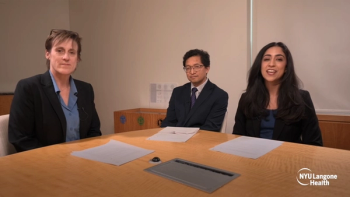
- Ophthalmology Times: July 15, 2021
- Volume 46
- Issue 12
Addressing GA by downregulating overactive complement system
GT005 designed to induce local production of recombinant complement factor I.
Reviewed by Nadia Waheed, MD, MPH
The interim data from the FOCUS trial (NCT03846193), a first-in-human phase 1/2 gene therapy study, showed that GT005 (Gyroscope Therapeutics Limited), an investigational gene therapy, is well tolerated in patients with geographic atrophy (GA) secondary to
GT005 is designed to induce local production of recombinant complement factor I (CFI).
Related:
Following administration of GT005, most patients had increases of the vitreous CFI levels, with an average increase of 146% compared to baseline. CFI is believed to be instrumental in downregulating the overactive complement system, a driver of the disease, according to Nadia Waheed, MD, MPH, an assistant professor of ophthalmology at Tufts Medical School, Tufts New England Eye Center, Boston, Massachusetts, and chief medical officer of Gyroscope Therapeutics.
The study was able to demonstrate that, in addition to the increased CFI levels, there was also a sustained decrease in Ba and C3, proteins associated with complement overactivation that lead to inflammation and disease.
“Uncontrolled accumulation of C3b results in an imbalance between the amplification cycle and the downregulation loop,” Waheed said. “The introduction of CFI restores the balance between the 2 cycles by downregulating the amplification pathway and sequestering C3, making CFI well suited for gene therapy.”
Related:
The trial
Three doses of GT005, a recombinant adeno-associated virus type 2-based investigational gene therapy, are being evaluated in patients in the FOCUS trial using transvitreal subretinal delivery in cohorts 1 to 4 and using subretinal delivery via the Orbit (Gyroscope Therapeutics) subretinal delivery system in cohorts 5 to 7.
Waheed reported results from patients in cohorts 1 to 4. Safety data were available for 19 patients; biomarker data were available from 10 patients from whom at least 2 biomarker samples were collected and analyzed.
The 3 doses were generally well tolerated and there was no evidence of inflammation related to the treatment. Choroidal neovascularization developed in 1 eye and was treated successfully with anti-VEGF.
Twelve adverse events, mostly mild, were related to the surgical procedure. Two patients had transient increases in intraocular pressure that subsequently resolved.
There were no serious adverse events reported related to the gene therapy or the surgical procedure.
Related:
The visual acuity was monitored as a safety parameter and it was preserved out to 48 weeks in the treated eyes.
The study patients underwent vitrectomy, which provided the opportunity to evaluate vitreous samples for protein biomarker (CFI, Ba and C3 breakdown product) data at baseline and various time points to evaluate whether the gene therapy was performing as intended.
Waheed offered details on the CFI levels in the dose-escalation groups.
“We saw notable elevations of CFI levels in all of the dose groups,” she explained. “There was a substantial increase in the CFI levels in all patients except 1.”
She said the response appeared to be durable over time in the 6- and 12-month samples obtained. One patient had= 84-week data showing a sustained increase in CFI levels with the lowest dose.
Related:
The hope is that increasing CFI production will dampen the overactivity of the system and reduce inflammation.
Previously published data suggested that a 40% to 50% dampening of the pathways could reduce risk for these patients.
Early data from the FOCUS trial showed 41% and 42% respective reductions in Ba and C3 breakdown products.
This effect lasted out to the last samples taken at 24 to 56 weeks, which suggests treatment durability.
Two randomized controlled phase 2 studies of GT005 are ongoing. One of the studies, EXPLORE (NCT04437368), is evaluating patients with GA with a rare variant in the CFI gene. The other study, HORIZON (NCT04566445), is evaluating a broad cohort of GA patients who do not carry the CFI variant.
According to Waheed, complement overactivation has been implicated in the pathogenesis of AMD.
Related:
“CFI is a natural downregulator of the complement system and GT005 is an investigational gene therapy designed to induce expression of CFI after delivery to the subretinal space,” she concluded.
To date, all doses of GT005 have been well tolerated in the phase 1/2 trial in patients with GA. The early data showed that most patients had increases in the CFI levels and downstream modulation of complement biomarkers.
---
Nadia Waheed, MD, MPH
E: [email protected]
This article is adapted from Waheed’s presentation at the Bascom Palmer Angiogenesis, Exudation, and Degeneration virtual conference. Waheed is the chief medical officer for Gyroscope Therapeutics Limited, the company that sponsored the study under discussion.
Articles in this issue
over 4 years ago
Expectations are on rise for presbyopia-correcting therapeuticover 4 years ago
Focusing on postinjection endophthalmitisover 4 years ago
The benefits of cryopreserved amniotic membrane during COVID-19over 4 years ago
CRISPR technology: A hot topic in gene therapyover 4 years ago
VA and visual function go the way of ocular inflammationover 4 years ago
Bariatric surgery may lead to decreased risk of cataractNewsletter
Don’t miss out—get Ophthalmology Times updates on the latest clinical advancements and expert interviews, straight to your inbox.













































